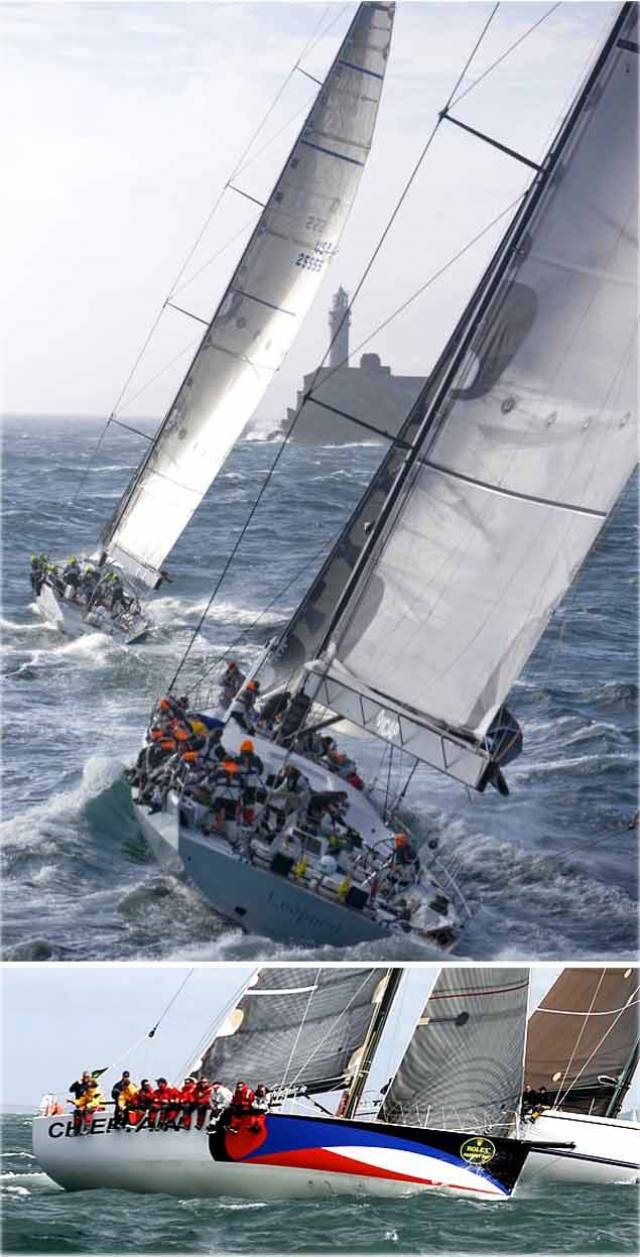In August 2007, a lone Irish boat swept quickly towards the finish of the Fastnet Race at Plymouth. Groups of larger craft had finished ahead of her, and soon a rush of other boats would follow in her wake. But when Ger O’Rourke of Limerick brought his Cookson 50 Chieftain across the line, he and his crew had the stage to themselves writes W M Nixon
They felt they’d done quite well, but wouldn’t know for sure until hundreds of other boats had been timed in. However, as the hours ticked away, Chieftain’s crew closed in on an overall win which had been achieved despite losing their main electronics before getting past the Lizard on the rough outward passage, and despite having been on the Waiting List rather than the limited-numbers Official Entry List until only a few days before the race actually started.
Chieftain’s owner Ger O’Rourke seemed to thrive on such uncertainty, and as his proposed crew included the formidable talents of the legendary Jochem Visser, he knew that once the Chieftain entry was given the nod, they’d very quickly have a full complement to take on the race.
Other entries - dutifully made many months in advance - fell away as start time approached. A heavy weather forecast may have played a role in this. But it didn’t faze Chieftain’s owner, as his programme that year had already included taking second overall in the rugged New York to Hamburg race, and he knew his canting-keel Farr-designed boat was more truly race-ready than most of the fleet. Getting officially acceptance into the fold, when it came, just seemed part of a larger plan.
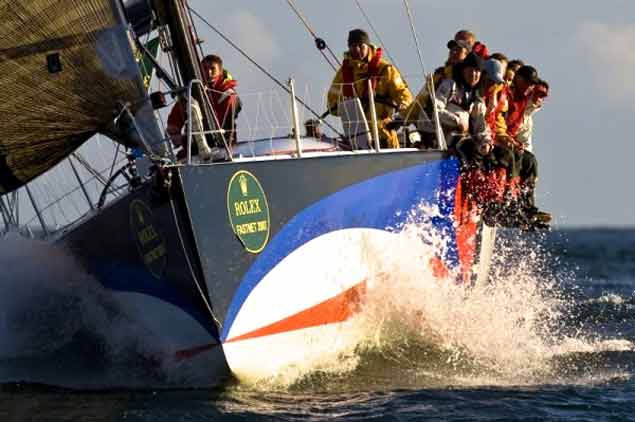 In the last of the evening sun, Chieftain approaches the finish line Plymouth with Ger O’Rourke on the hel
In the last of the evening sun, Chieftain approaches the finish line Plymouth with Ger O’Rourke on the hel
 They’ve done it. Chieftain wins the Rolex Fastnet Race 2007. The lack of anything approaching a crew uniform is testament to the fact that she was accepted as an entry only after more than forty boats had dropped out beforehand
They’ve done it. Chieftain wins the Rolex Fastnet Race 2007. The lack of anything approaching a crew uniform is testament to the fact that she was accepted as an entry only after more than forty boats had dropped out beforehand
In a stormy race, many boats pulled out, but in the weather pattern which developed, Chieftain was exactly the right size and type of boat to do best. And she’d the crew to enable her to do this, despite having to rely for much of the race on tiny hand-held GPS devices and increasingly wet paper charts.
After the finish, Chieftain’s motley crew could see the growing inevitability of the final result. But the owner refused to go up the town to buy himself a crisp new white shirt for the prize-giving until he’d been shown a document confirming that he was indeed the undisputed overall winner.
Sometime it seems as though it happened only yesterday. But sometimes it seems a very, very long time ago, as Ireland has been through a ferocious economic mincing machine since then. Either way, the reality is that the Rolex Fastnet Race 2017, which starts tomorrow from Cowes in a sequence beginning at 1100 hrs for a record entry list of 384 boats, will mark the Tenth Anniversary of Ireland’s greatest win in an event which is a pillar of world sailing. And it’s an event in which Irish boats have been involved since it was first sailed in 1925 with just seven starters. Our gallant representative, Harry Donegan from Cork with the 17-ton gaff cutter Gull, placed third overall.
Today, the increasing internationalism of sailing – and offshore and ocean racing in particular - is evident throughout the fleet, so much so that it’s almost the norm to have a crew with some mixing of nationalities. Thus in taking a preview, it’s increasingly difficult to say which entry is or isn’t Irish, regardless of simply taking it from the national flag indicated beside the name on the RORC’s entry list.
On top of that, with an entry of 384 boats and entries not officially finalized until the Race Office has the complete crew list with the essential personal information, you can readily visualize how things have been in and around the organisers’ office these past few days.
After one of the roughest Cowes Weeks in years comes to a close today, the Rolex Fastnet Race is expected to start tomorrow in moderate conditions with the hugely impressive sight of the enormous fleet sweeping westward out of the Solent through the Needles Channel, and facing the prospect of a beat down Channel to Land’s End.
Fair weather sailors had been hoping that the ridge from the Azores High might build northeastwards to give summer sailing for the 605-mile race. But we’re in unstable meteorological conditions with the restless Jetstream dictating weather and wind changes, and not all of these can be closely predicted.
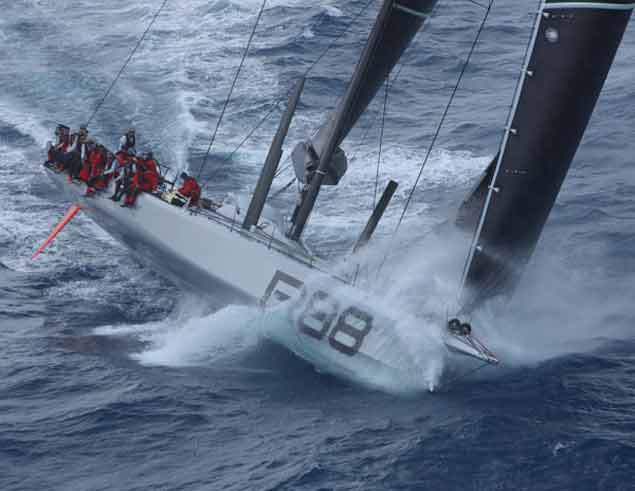 If it turns out to be a big boat race, with her unrivalled trio of line honours and IRC wins in three recent RORC races, George David’s Rambler 88 has to be a favourite
If it turns out to be a big boat race, with her unrivalled trio of line honours and IRC wins in three recent RORC races, George David’s Rambler 88 has to be a favourite
Majority opinion has it that it will be a big boat race, as the nor’westers will remain fresh to strong – or even more – until Wednesday, when another little ridge might ease things back for the smaller craft. If it is a big boat race, then in IRC Overall the smart money will be on George David’s Rambler 88. She has been re-writing the form book these past two years, as she took line honours and the overall win in IRC in the Volvo Round Ireland Race last year, and this year she has repeated the remarkable double in both the RORC’s Cowes-St Malo Race and the RORC’s Channel Race.
Certainly it will be interesting to see how she does against the newest 100ft super-maxi, the Ludde Ingvall-skippered CQS from Australia, which was shipped to Europe with the Fastnet Race as her main priority. But in her brief time in the northern hemisphere so far, things haven’t gone her way. She went out to do the Round the Island Sprint on Wednesday with the other biggies when they’d gale fore winds around the south end of the isle of Wight, and while CQS had sail trouble and didn’t excel, the seven brand new Volvo 65s had a magnificent race, with Mapfre (skipper Xabi Fernandez) winning, and the first three breaking the Round the Island Mono-hull Record.
 The completely new strictly one-design Volvo 65 Mapfre (skipper Xabi Fernandez) on her way to winning the Round Isle of Wight sprint on Wednesday, and creating a new record while she was at it.
The completely new strictly one-design Volvo 65 Mapfre (skipper Xabi Fernandez) on her way to winning the Round Isle of Wight sprint on Wednesday, and creating a new record while she was at it.
There was almost an Irish interest in this as our own Olympic Silver Medallist Annalise Murphy was being lined up for a crew test for the all-women panel on Dee Caffari’s Volvo 65
Turn The Tide On Plastic, but unfortunately an injury in the recent International Moth Worlds (in which she was top woman) has side-lined her for a while, but she may be aboard post-Fastnet.
Also up among the biggies, Irish interest will be intense for the foiling IMOCA 60 Hugo Boss, where new Afloat.ie “Sailor of the Month” Nin O’Leary is teaming up as joint skipper with seasoned campaigner Alex Thompson. O’Leary has sailed on Hugo Boss before, but the Fastnet is a case of going in at the deep end, as their main rivals at the big boat end of a two-part 69-strong two-handed division will be the legendary Jeanne-Pierre Dick and three-times Figaro winner Yann Elies in the foiling IMOCA 60 St Michel-Virbac.
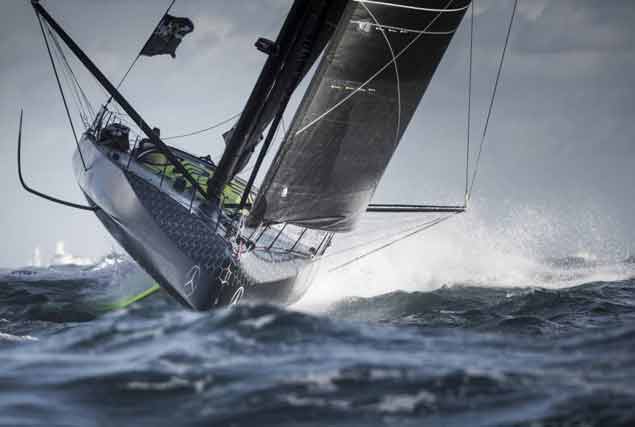 Is it a bird, is it a plane, is it a manta ray….? Hugo Boss will be raced by Alex Thompson and Nin O’Leary
Is it a bird, is it a plane, is it a manta ray….? Hugo Boss will be raced by Alex Thompson and Nin O’Leary
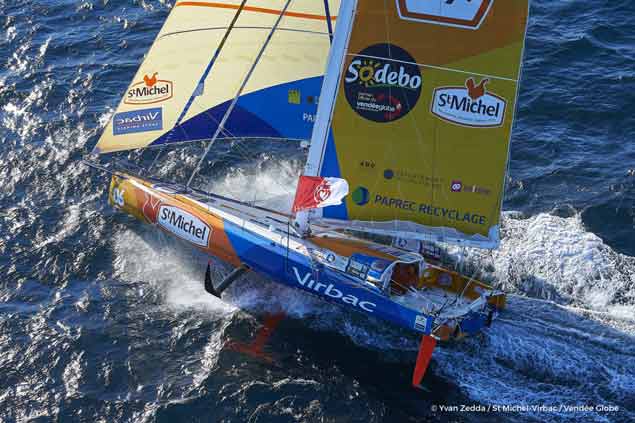 Jeanne-Piere Dick’s StMichel-Virbac is likely to be Hugo Boss’s closest opponent
Jeanne-Piere Dick’s StMichel-Virbac is likely to be Hugo Boss’s closest opponent
The Fastnet fleet is like an awesome mountain range - it’s easy enough to discern the major peaks, but it’s only as you descend into the smaller mountains and the foothills that you feel some sense of identity and fellow-feeling with what’s around you, and for true aficionados, the IRC corrected time winners in class and overall is the real Rolex Fastnet Race.
Thus the main topic this year is can the French make it three in a row. And even better, can the incredible JPK marque from Lorient make it three in a row?
Back in 2013, the unthinkable happened. The overall winner was the French JPK 10.10 Night and Day, raced in the Two-Handed division by father-and-son crew Pascal and Alexis Loison. For those of us who can just about rub along with family on a boat, and prefer to be fully crewed, it took some time to get used to the idea of Night and Day’s superb win.
Then by 2015, JPK’s new design, the JPK 10.80, was starting to make waves, and went on to win the Rolex Fastnet Race overall in the form of veteran Gery Trentesaux’s Courrier du Leon. Just to show it was no flash in the pan, a sister-ship – also skippered by Trentesaux – won her class in the next Rolex Sydney-Hobart Race, and now in 2017 Paul O’Higgins’ JPK 10.80 Rockabill VI has won the Volvo Dun Laoghaire-Dingle Race overall in June while in July another sister-ship, Yes! skippered by Nin O’Leary, won the big-fleet Round the Island by an unusually wide margin.
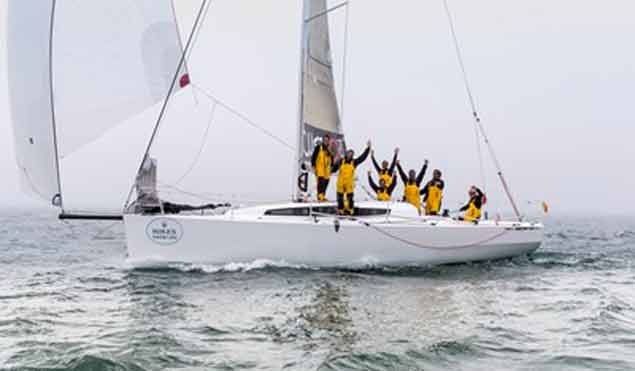 The JPK 10.80 Courrier du Leon (Gery Trentesaux) winning the Rolex Fastnet Race 2015
The JPK 10.80 Courrier du Leon (Gery Trentesaux) winning the Rolex Fastnet Race 2015
So these are still the boats to beat. But as we’ve learned in Irish offshore racing, a well-sailed J/109 can sometimes get the better of them, so although she’s not strictly Irish, we reckon that the J/109 Mojito (Peter Dunlop & Vicky Cox from Pwllheli) is Honorary Irish, and she’s very much in the lineup for tomorrow’s start, as is the Irish National Sailing School’s J/109 Jedi skippered by Kenneth Rumball, which is in both the Open Division and in the racing for the Roger Justice Trophy for sailing schools.
This is hotly contested with more than 30 offshore sailing and racing schools involved, and in 2015 it was won by Irish Offshore Sailing of Dun Laoghaire with Ronan O Siochru skippering the Sunfast 37 Desert Star. IOS is back this year with Desert Star, and while a fine camaraderie had built up among her crew, the rules for participation as a sailing school means you have to carry a significant proportion of first timers, thus two of Desert Star’s crew from 2015, Louise Gray and Jacques Diedricks, have transferred to another non-school Dun Laoghaire-based Fastnet contender, Brendan Couglan’s Sunfast 37 Windshift.
 At the prize-giving in Plymouth, RORC Commodore Michael Boyd presents Ronan O Siochru with the Roger Justice Trophy for the best-placed sailing school entry in the Rolex Fastnet Race 2015. Boyd himself had won the Gull Salver for the top-placed Irish boat.
At the prize-giving in Plymouth, RORC Commodore Michael Boyd presents Ronan O Siochru with the Roger Justice Trophy for the best-placed sailing school entry in the Rolex Fastnet Race 2015. Boyd himself had won the Gull Salver for the top-placed Irish boat.
Irish Offshore Sailing and Irish International Sailing School have of course competed against each other before, in last year’s Volvo Round Ireland, when INSS did best winning the schools division and placing tenth overall. But that was in the Reflex 38 Lynx. The more recently-acquired J/109 gives a new perspective, but here too the rules about having a certain proportion of trainees in your crew have affected personnel selection, and Kenneth Rumball has been unable to take his right-hand man from the 2016 Round Ireland win, Luke Malcolm, who has transferred to Paul Egan’s Dun Laoghaire-based First 35 Platinum Blonde to gain his Fastnet spurs.
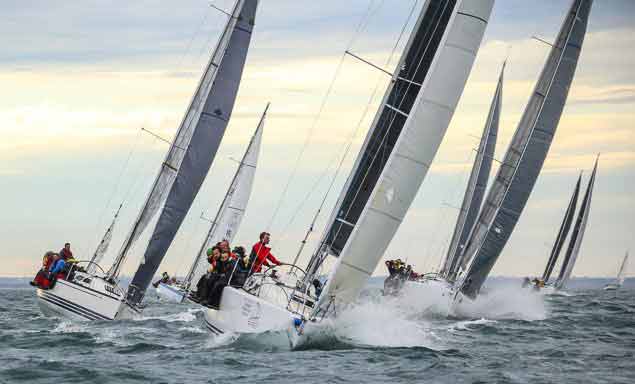 The Irish National Sailing School’s J/109 Jedi ahead of the pack in the ISORA Lyver Trophy Race, part of the buildup in the training towards the Rolex Fastnet Race 2017
The Irish National Sailing School’s J/109 Jedi ahead of the pack in the ISORA Lyver Trophy Race, part of the buildup in the training towards the Rolex Fastnet Race 2017
Some additions and insights into the eleven Irish Fastnet entries listed in Afloat.ie are intriguing. For instance, Alan Hannon’s Reichel Pugh 45 Katsu was a very attractive participant in the 2016 Volvo Round Ireland Race, and a closer look at the RORC’s list shows her as skippered by Richie Fearon of Lough Swilly Yacht Club, who navigated the overall winner Tanit in the 2014 Round Ireland, and has formidable international connections which could see Katsu racing with a stellar crew.
Of similar size but with a rating of only 1.096 compared to Katsu’s stratospheric 1.240, the First 44.7 Lisa is skippered by our own Michael Boyd, Commodore RORC. Not only is he defending Irish champion in the Fastnet as he won the Gull Salver with Quokka in 2015, but this year he has been doing mighty well, winning overall in the RORC’s Morgan Cup Race in June.
Another sensibly-rated boat to watch is Harry Heijst’s veteran Winsome, an alloy early version of the Swan 41, built 1972. Though Winsome is proudly Dutch (sail number is NED 118), she’s something of a star in the Solent, and is different from the slightly later GRP Swan 41 with a cockpit/bridge-deck arrangement which many owners of standard Swans of a certain size and vintage would dearly like to emulate, as it greatly improves the boat’s cockpit ergonomics and companionway access. If this is what you want, lads, get out the chainsaw……
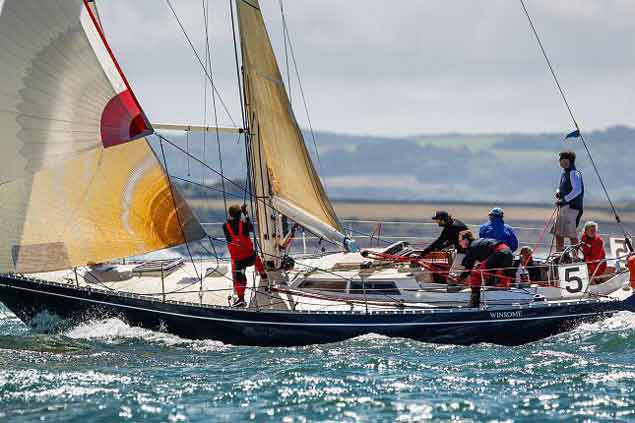 Laura Dillon helming the vintage Swan 41 Winsome at the current Cowes Week. Although Winsome’s alloy hull is similar to a Swan 41, her cockpit/companionway/cabintop arrangement is a considerable improvement
Laura Dillon helming the vintage Swan 41 Winsome at the current Cowes Week. Although Winsome’s alloy hull is similar to a Swan 41, her cockpit/companionway/cabintop arrangement is a considerable improvement
The competitive Winsome’s hull has stayed exactly the same, which means she retains all the rating advantages of her age, and clocks in at just 0.990. This makes her very competitive indeed, particularly in a breeze, but only if you have the right person on the wheel. And for some years now that right person has been Howth ex-Pat sailing star Laura Dillon, a former Helmsmans Champion who is now London-based and the extremely effective regular driver on Winsome when she’s not away on some other sailing campaign.
Winsome has been making hay in this windy Cowes Week, and at the time of writing was leading her class well clear, and only rivalled for Boat of the Week in all classes by another veteran yacht with strong Fingal connections, the superbly tuned and sailed 1939-vintage Whooper of Giovanni Belgrano at the top of Class 6. In another life, Whooper used to be the Star of Skerries, owned by Christy and Joe Fox and based at Skerries in North Fingal.
But while Whooper isn’t down to do the Fastnet Race as her owner is probably doing it in his day job as a top professional, Winsome most definitely is. And with the forecast of early brisk breezes and lots of beating, she might be one to watch if she can stay ahead of the lightening breezes which may occur later next week.
 They may not make sterns like that any more, but after 41 years the 1976 Half Ton World Champion Silver Shamrock is still going strong, and she’s the smallest boat entered in the Rolex Fastnet Race 2017
They may not make sterns like that any more, but after 41 years the 1976 Half Ton World Champion Silver Shamrock is still going strong, and she’s the smallest boat entered in the Rolex Fastnet Race 2017
Another one to watch, this time for old sake’s sake, is the smallest boat in the fleet, Stuart Greenfield’s 30ft Silver Shamrock. This is the Ron Holland-designed boat with which Harry Cudmore won the Half Ton Worlds in Trieste in 1976. That’s all of forty-one years ago now, yet little Silver Shamrock is still going strong, and with the Half Ton Classics coming up at Kinsale in a dozen days’ time, we can salute Silver Shamrock and feel a sense of identity with her.
This isn’t a feeling aroused by contemplating the biggest boat which has ever raced in the Fastnet, this year’s monster, the 115ft Nikata. An absurdly large vessel. At race’s end, you’d only know a quarter of the crew. And even she’ll be eclipsed if the 130ft trimaran Spindrift 2 – currently not listed as an entry – somehow manifests herself on Sunday heading down Solent. Will there be room for the two of them?
 The crew will just have to wear name tags…..the 115ft Nikita is the largest mono-hull in the Rolex Fastnet Race 2017
The crew will just have to wear name tags…..the 115ft Nikita is the largest mono-hull in the Rolex Fastnet Race 2017



























